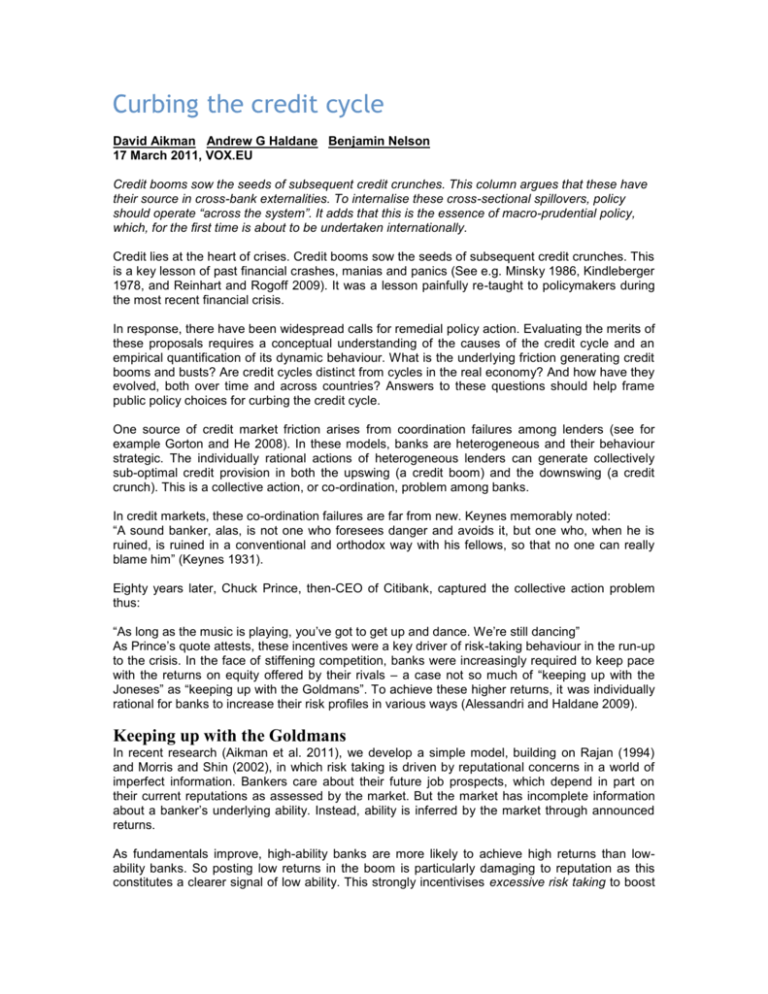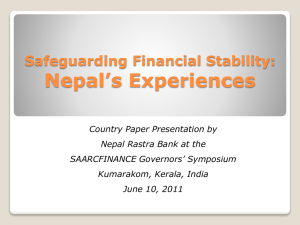Curbing the credit cycle
advertisement

Curbing the credit cycle David Aikman Andrew G Haldane Benjamin Nelson 17 March 2011, VOX.EU Credit booms sow the seeds of subsequent credit crunches. This column argues that these have their source in cross-bank externalities. To internalise these cross-sectional spillovers, policy should operate “across the system”. It adds that this is the essence of macro-prudential policy, which, for the first time is about to be undertaken internationally. Credit lies at the heart of crises. Credit booms sow the seeds of subsequent credit crunches. This is a key lesson of past financial crashes, manias and panics (See e.g. Minsky 1986, Kindleberger 1978, and Reinhart and Rogoff 2009). It was a lesson painfully re-taught to policymakers during the most recent financial crisis. In response, there have been widespread calls for remedial policy action. Evaluating the merits of these proposals requires a conceptual understanding of the causes of the credit cycle and an empirical quantification of its dynamic behaviour. What is the underlying friction generating credit booms and busts? Are credit cycles distinct from cycles in the real economy? And how have they evolved, both over time and across countries? Answers to these questions should help frame public policy choices for curbing the credit cycle. One source of credit market friction arises from coordination failures among lenders (see for example Gorton and He 2008). In these models, banks are heterogeneous and their behaviour strategic. The individually rational actions of heterogeneous lenders can generate collectively sub-optimal credit provision in both the upswing (a credit boom) and the downswing (a credit crunch). This is a collective action, or co-ordination, problem among banks. In credit markets, these co-ordination failures are far from new. Keynes memorably noted: “A sound banker, alas, is not one who foresees danger and avoids it, but one who, when he is ruined, is ruined in a conventional and orthodox way with his fellows, so that no one can really blame him” (Keynes 1931). Eighty years later, Chuck Prince, then-CEO of Citibank, captured the collective action problem thus: “As long as the music is playing, you’ve got to get up and dance. We’re still dancing” As Prince’s quote attests, these incentives were a key driver of risk-taking behaviour in the run-up to the crisis. In the face of stiffening competition, banks were increasingly required to keep pace with the returns on equity offered by their rivals – a case not so much of “keeping up with the Joneses” as “keeping up with the Goldmans”. To achieve these higher returns, it was individually rational for banks to increase their risk profiles in various ways (Alessandri and Haldane 2009). Keeping up with the Goldmans In recent research (Aikman et al. 2011), we develop a simple model, building on Rajan (1994) and Morris and Shin (2002), in which risk taking is driven by reputational concerns in a world of imperfect information. Bankers care about their future job prospects, which depend in part on their current reputations as assessed by the market. But the market has incomplete information about a banker’s underlying ability. Instead, ability is inferred by the market through announced returns. As fundamentals improve, high-ability banks are more likely to achieve high returns than lowability banks. So posting low returns in the boom is particularly damaging to reputation as this constitutes a clearer signal of low ability. This strongly incentivises excessive risk taking to boost short term returns as fundamentals improve. This dynamic sows the seeds for procyclical variation in risk taking and contributes to the generation of a credit cycle. The medium-term implications of short-term excessive risk taking are an eventual crystallisation of large scale losses together with widespread financial distress. What are the empirical implications of our model? First, strategic complementarities incentivise banks to adopt risky strategies in a coordinated fashion during the boom. So the dynamics of the model predict that we should observe cycles in financial activity at a macroeconomic level. Initial productivity improvements are amplified into lending booms, which are followed by credit busts and, potentially, crises. Second, at a microeconomic level, the coordination of risky strategies during the boom should compress the dispersion of bank earnings, as low ability banks masquerade as high ability banks during good times. But during the bust, when the macro state turns bad, the dispersion of banks’ earnings should increase as low ability types crystallise losses while high ability types do not. At the macro level, we document the existence of strong cyclical variation in real credit for a sample of 12 developed countries collected by Schularick and Taylor (2009). These cyclical fluctuations over the medium term (with a duration of 8-20 years) are not only statistically significant, but also strongly associated with the incidence of financial stress. The cycle we identify for the UK is shown in Figure 1. Not only is the duration of the cycle in real credit different from the business cycle, so too is its amplitude – around twice that of GDP in the medium term and roughly five times that of GDP at conventional business cycle frequencies. Cycles in asset prices are even greater in amplitude. Figure 1. Medium-term fluctuations in real credit and real GDP, UK, 1880-2008. Source: authors’ calculations At the micro level, Figure 2 plots a time series of the cross-sectional dispersion of equity returns for major UK banks, alongside dispersion for the top 100 Private Non-Financial Companies (PNFCs). Measures of return dispersion are consistently and statistically significantly lower for banks than for non-banks. And dispersion tended to fall over the long credit boom during this century. Measures of equity return dispersion hit all-time lows at the height of the recent credit boom in 2006-2007, before exploding in 2008. Figure 2. Cross sectional dispersion of equity returns of major UK banks and top 100 UK Private Non-Financial Companies (by market cap) Source: CapitalIQ and authors’ calculations. We also examined return patterns among the largest global banking and non-financial firms. The pattern is the same. We observe a compression of returns during credit booms and a dispersion in busts, with the cyclicality becoming more marked through time. This suggests an increase in the degree of coordination of global banks’ activities after the financial liberalisation of the 1980s, indicating that credit cycles may have become increasingly synchronous globally. Pair-wise correlations between 12 advanced countries’ medium-term credit cycles for two postwar sub-samples, 1945-79 and 1980-2008, confirm that impression (Figure 3). A shift to the right of the cumulative distribution indicates an increase in the degree of cross-country correlation. Figure 3. Cumulative distribution function of cross-country correlations of credit cycles Source: authors’ calculations Policy implications Individual banks may fail to internalise the reputational externalities their lending actions impose on others. The result is a periodic tidal wave of credit during the boom followed by protracted credit drought during the crunch. Chuck Prince’s disco inferno causes murder on the dance floor. These credit cycle externalities provide justification for state intervention to help coordinate lending expectations and actions by banks. One means of curbing credit cycle frictions might be through monetary policy – either by ensuring it moderates appropriately the business cycle (Taylor 2010) or, more ambitiously, by having it play a wider role in curtailing financial imbalances (Borio and White 2004). The evidence we present is not especially encouraging on that front. The frequency and amplitude of the business and credit cycles is quite different. Monetary policy may be an inefficient tool for calming the credit cycle, if at the same time it is to moderate the business cycle. Micro-prudential policy, aimed at tackling financial imbalances in individual financial institutions, may also be ineffective for dealing with aggregate credit cycles. That is because bank-specific actions will not, by themselves, internalise the spillovers that arise across banks over the credit cycle. They may even worsen them if they allow individual banks to steal a reputational march over their competitors. This coordination problem suggests systematic, across-the-system actions are needed to curtail effectively credit booms and busts. This is one dimension of macro-prudential policy. To be effective, these policies need to increase the long-term cost of credit extension to banks during booms and, as importantly, to lower these costs during busts. These actions would help smooth out credit supply over the cycle. There are a variety of macro-prudential tools which could have this effect, including pro-cyclical capital and liquidity requirements, or remuneration packages that tie individual earnings more closely to long term performance (Bank of England 2009, Kashyap et al. 2010, G30 2010). Credit spillovers occur across borders as well as across banks. This suggests macro-prudential policies need also to have an international dimension if they are to tackle credit externalities. This is recognised in the macro-prudential policy framework currently being discussed by the international regulatory community (BIS 2010). For example, judgements on local credit conditions determine the amounts of capital to be held by international banks on their exposures in those countries. This reciprocity feature should help to reduce the arbitrage risks posed by the internationalisation of the credit cycle. The state of macro-prudential policy today has many similarities with the state of monetary policy just after the Second World War. Data is incomplete, theory patchy, policy experience negligible. Monetary policy then was conducted by trial and error. The same will be true of macro-prudential policy now. Mistakes will be made. But as experience with the other arms of macroeconomic policy, as well as during the credit crunch, has taught us, the biggest mistake would be not to try. References Aikman, David, Andrew G Haldane, and Benjamin Nelson (2011), “Microfoundations for modern macroeconomics”, March. Alessandri, P and AG Haldane (2009), “Banking on the State”, Bank of England. Bank of England (2009), “The Role of Macroprudential Policy – A Discussion Paper”. BIS (2010), “Countercyclical Capital Buffer Proposal - Consultative Document”, Basel Committee on Banking Supervision, Bank for International Settlements. Borio, C and WR White (2004), “Whither Monetary and Financial Stability? The Implications of Evolving Policy Regimes”, Bank for International Settlements Working Papers 147. Gorton, G and P He (2008), “Bank Credit Cycles”, Review of Economic Studies 75(4): 1181-1214. Group of Thirty (2010), Enhancing Financial Stability and Resilience: Macroprudential Policy, Tools, and Systems for the Future. Kashyap, AK, JC Stein, and S Hanson (2010), “A Macroprudential Approach to Financial Regulation”, Forthcoming in Journal of Economic Perspectives. Keynes, JM (1931), “The Consequences to the Banks of the Collapse of Money Values”, Essays in Persuasion, Macmillan Publishers. Kindleberger, CP (1978), Manias, Panics and Crashes: A History of Financial Crises, Palgrave Macmillan. Minsky, HP (1986), Stabilizing an Unstable Economy, Yale University Press. Morris, S and HS Shin (2003), "Global Games: Theory and Applications", Advances in Economics and Econometrics (Proceedings of the Eighth World Congress of the Econometric Society), Cambridge University Press. Rajan, RG (1994), "Why Bank Credit Policies Fluctuate: A Theory and Some Evidence", Quarterly Journal of Economics 109(2):399-441. Reinhart, CM and KS Rogoff (2009), This Time is Different: Eight Centuries of Financial Folly, Princeton University Press. Schularick, M and AM Taylor (2009), “Credit Booms Gone Bust: Monetary Policy, Levrage Cycles and Financial Crises, 1970-2008”, NBER Working Paper Series 15512. Taylor, J (2010), “Commentary: Monetary Policy After the Fall”, Presentation at the Symposium “Macroeconomic Challenges: The Decade Ahead”, Jackson Hole.









